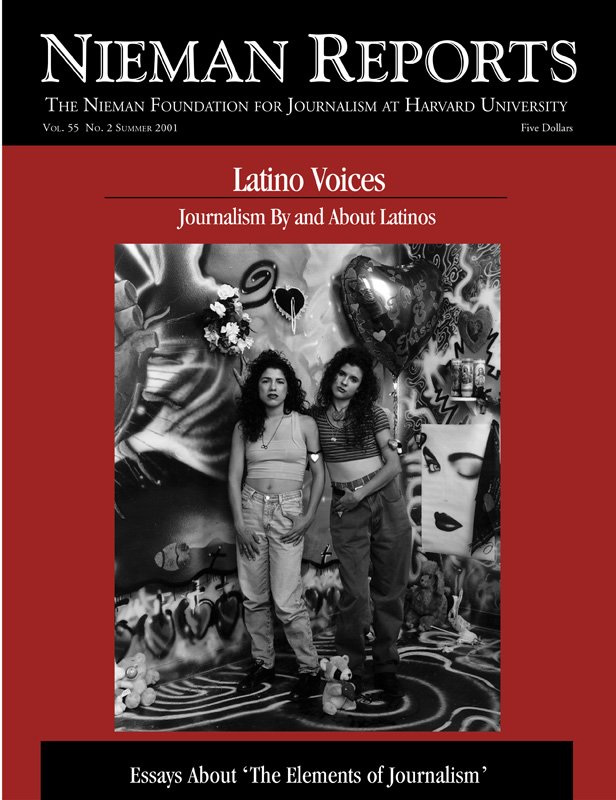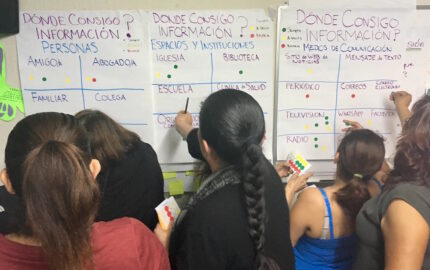
Latino Voices: Journalism By and About Latinos
How is the rapid increase in Hispanic American population affecting communities? What are the economic, social, cultural and educational benefits and hardships brought about by this significant demographic shift? Will the numbers and force of Hispanic voters alter the nation’s political landscape? The questions to be raised and stories to be told vary as greatly as do people portrayed by the word “Hispanic.”
For two years, I’ve been overseeing the Los Angeles Times’s Latino Initiative, a newsroom-wide project that assigns bilingual reporters (not all of whom are Latino) to beats in which we expect news and feature stories about the region’s many Latino communities to emerge.
During this time, I’ve had many opportunities to explain this initiative to many audiences, mostly community groups in Los Angeles’s Latino barrios and meetings of newspaper industry associations. I find it interesting, but not surprising, that the question newspaper colleagues ask most frequently is rarely raised by Latinos: Why are we doing it in English?
In other words, why isn’t a big, prosperous newspaper like the Times making an effort to penetrate the large Latino market in our circulation area—40 percent of the population in the five-county Los Angeles region, and getting bigger—by publishing the fine journalism we do in Spanish, the primary language spoken from Tijuana to Tierra del Fuego? Publishing in Spanish is, after all, the strategy being pursued by our two sister newspapers in Tribune Co. who also have large Latino immigrant communities in their cities. Newsday, in New York, publishes a Spanish-language daily called Hoy. And the Chicago Tribune publishes a weekly called Exito. At the Times we opted to not go the Spanish-language route for three reasons:
Also key to the Latino Initiative’s beginnings were former Times publisher Mark Willes and former editor Michael Parks. Both were very supportive when Tapias-Mansfield and I made a pivotal presentation to the newspaper’s senior management team in 1997. We argued that the newspaper needed to look past the conventional wisdom promulgated by Univision and its rival Spanish-language TV network Telemundo. Executives at these two networks would have media executives (and, not insignificantly, advertisers) believe that all Latinos want their news and entertainment in Spanish and prefer broadcast media to print.
In fact, the Latino market for news is much more complicated than that and getting more complicated with each passing day. That is because young Latinos being raised in immigrant families are rapidly assimilating to U.S. life. Among other things, that means they are as comfortable with English as they are with Spanish. Additionally, Tapias-Mansfield’s market research indicated that these young, bilingual Latinos are better educated than their parents, earn higher salaries, and are likely to remain in the United States their entire lives rather than returning to their ancestral Latin American homelands.
They are, in short, a new, emerging middle class for cities such as Los Angeles. And that new middle class should be a welcoming audience for a quality newspaper like the Times. This requires that we, of course, make an effort to reach them with news and features they find interesting and engaging and accurately reflecting life as they live it.
This is really what the Latino Initiative is all about. We took a dozen of our best young journalists, all of them bilingual and knowledgeable about the local Latino community, and assigned them to new beats where we expected they would find stories of interest to Latino readers or that would educate non-Latino readers about their Latino neighbors. The beats we focused on were neither new nor innovative—religion, entertainment, sports, small business, labor—but putting a fresh and different emphasis on them enhanced our coverage of the local community.
Here are a few examples of the coverage that has emerged:
We tried to build flexibility into the Latino Initiative. We emphasized to the staff that it was always going to be a work in progress and that beat assignments were not cast in stone. I am working even now with the Times’s new editor, John Carroll, and our new managing editor, Dean Baquet, to revise and refine the Latino beats further. For instance, our initial focus on popular culture will shift to include more coverage of the evolution of serious culture—theater, literature, the fine arts—in the Latino community. A final point we stressed when we launched the Latino Initiative—and which Carroll has agreed is fundamental to the endeavor—is that its goal is to work its way out of existence.
We hoped, initially, and continue to believe, that by coming up with interesting stories and features with a Latino angle, the initiative team will convince their newsroom colleagues to also be on the lookout for Latino-focused stories on their beats. And that appears to be happening. Of the roughly 150 Latino-themed stories published by the Times since the start of this year, staffers not assigned to the Latino Initiative beats wrote about a third of them.
I hope that, eventually, it will be as natural for our reporters to look for the Latino angle to a big story as it is to look for the California angle to a national story. Given how the demographics are shaping up in Los Angeles—46 percent of the city’s population is Latino, according to the 2000 Census—that might be the only way the Times will continue to prosper and practice the kind of high-quality journalism in which we take justifiable pride.
Frank del Olmo, a 1988 Nieman Fellow, is associate editor of the Los Angeles Times. He was a member of a team of Times reporters awarded a Pulitzer Prize Gold Medal in 1984 for a series of articles about southern California’s Latino community.
During this time, I’ve had many opportunities to explain this initiative to many audiences, mostly community groups in Los Angeles’s Latino barrios and meetings of newspaper industry associations. I find it interesting, but not surprising, that the question newspaper colleagues ask most frequently is rarely raised by Latinos: Why are we doing it in English?
In other words, why isn’t a big, prosperous newspaper like the Times making an effort to penetrate the large Latino market in our circulation area—40 percent of the population in the five-county Los Angeles region, and getting bigger—by publishing the fine journalism we do in Spanish, the primary language spoken from Tijuana to Tierra del Fuego? Publishing in Spanish is, after all, the strategy being pursued by our two sister newspapers in Tribune Co. who also have large Latino immigrant communities in their cities. Newsday, in New York, publishes a Spanish-language daily called Hoy. And the Chicago Tribune publishes a weekly called Exito. At the Times we opted to not go the Spanish-language route for three reasons:
- We tried it once, and it didn’t work out very well. We published a Spanish-language weekly called Nuestro Tiempo (Our Times) for two years in the early 1990’s and, while it was a journalistic success, breaking some stories even before the Times did, it never made a profit.
- We are fortunate to now have a solid partnership with a quality Spanish-language daily in Los Angeles. The same family has published La Opinión for almost 75 years and is well-known and trusted in the local Latino community. One of the smartest investments the late Times Mirror Co. made was buying a 50 percent interest in La Opinión in the early ’90’s, at the same time we were experimenting with Nuestro Tiempo. That partnership is now in the hands of Tribune Co., which is making a greater effort to realize its full potential.
- Most importantly, marketing research by business-side colleagues indicated there was greater untapped potential for a newspaper like the Times in the English-language segment of the Latino market than in the Spanish-dominant segment. Martha Tapias-Mansfield, who had come to the Times from the Spanish-language Univision TV network to be the business manager for Nuestro Tiempo, helped us a lot in making this decision.
Also key to the Latino Initiative’s beginnings were former Times publisher Mark Willes and former editor Michael Parks. Both were very supportive when Tapias-Mansfield and I made a pivotal presentation to the newspaper’s senior management team in 1997. We argued that the newspaper needed to look past the conventional wisdom promulgated by Univision and its rival Spanish-language TV network Telemundo. Executives at these two networks would have media executives (and, not insignificantly, advertisers) believe that all Latinos want their news and entertainment in Spanish and prefer broadcast media to print.
In fact, the Latino market for news is much more complicated than that and getting more complicated with each passing day. That is because young Latinos being raised in immigrant families are rapidly assimilating to U.S. life. Among other things, that means they are as comfortable with English as they are with Spanish. Additionally, Tapias-Mansfield’s market research indicated that these young, bilingual Latinos are better educated than their parents, earn higher salaries, and are likely to remain in the United States their entire lives rather than returning to their ancestral Latin American homelands.
They are, in short, a new, emerging middle class for cities such as Los Angeles. And that new middle class should be a welcoming audience for a quality newspaper like the Times. This requires that we, of course, make an effort to reach them with news and features they find interesting and engaging and accurately reflecting life as they live it.
This is really what the Latino Initiative is all about. We took a dozen of our best young journalists, all of them bilingual and knowledgeable about the local Latino community, and assigned them to new beats where we expected they would find stories of interest to Latino readers or that would educate non-Latino readers about their Latino neighbors. The beats we focused on were neither new nor innovative—religion, entertainment, sports, small business, labor—but putting a fresh and different emphasis on them enhanced our coverage of the local community.
Here are a few examples of the coverage that has emerged:
- Los Angeles does not have an NFL football team, but soccer matches at the Rose Bowl and Los Angeles Memorial Coliseum often draw crowds in excess of 80,000 fans. Yet the Times never had a full-time soccer writer until the Latino Initiative.
- We also assigned a music writer to focus solely on Latin pop, and thus were the first major national publication to have a story about a then just-emerging star named Ricky Martin on our front page.
- We assigned a reporter to focus on workplace issues facing the Latino immigrants who are the backbone of Los Angeles’s blue-collar work force. Within a year, stories she broke had the national press writing about how a once moribund labor movement had been revitalized by union-organizing drives among Los Angeles’s janitors, hotel and restaurant workers, and dry wallers.
We tried to build flexibility into the Latino Initiative. We emphasized to the staff that it was always going to be a work in progress and that beat assignments were not cast in stone. I am working even now with the Times’s new editor, John Carroll, and our new managing editor, Dean Baquet, to revise and refine the Latino beats further. For instance, our initial focus on popular culture will shift to include more coverage of the evolution of serious culture—theater, literature, the fine arts—in the Latino community. A final point we stressed when we launched the Latino Initiative—and which Carroll has agreed is fundamental to the endeavor—is that its goal is to work its way out of existence.
We hoped, initially, and continue to believe, that by coming up with interesting stories and features with a Latino angle, the initiative team will convince their newsroom colleagues to also be on the lookout for Latino-focused stories on their beats. And that appears to be happening. Of the roughly 150 Latino-themed stories published by the Times since the start of this year, staffers not assigned to the Latino Initiative beats wrote about a third of them.
I hope that, eventually, it will be as natural for our reporters to look for the Latino angle to a big story as it is to look for the California angle to a national story. Given how the demographics are shaping up in Los Angeles—46 percent of the city’s population is Latino, according to the 2000 Census—that might be the only way the Times will continue to prosper and practice the kind of high-quality journalism in which we take justifiable pride.
Frank del Olmo, a 1988 Nieman Fellow, is associate editor of the Los Angeles Times. He was a member of a team of Times reporters awarded a Pulitzer Prize Gold Medal in 1984 for a series of articles about southern California’s Latino community.


